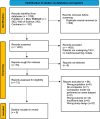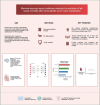Machine-learning versus traditional methods for prediction of all-cause mortality after transcatheter aortic valve implantation: a systematic review and meta-analysis
- PMID: 39842939
- PMCID: PMC11784135
- DOI: 10.1136/openhrt-2024-002779
Machine-learning versus traditional methods for prediction of all-cause mortality after transcatheter aortic valve implantation: a systematic review and meta-analysis
Abstract
Background: Accurate mortality prediction following transcatheter aortic valve implantation (TAVI) is essential for mitigating risk, shared decision-making and periprocedural planning. Surgical risk models have demonstrated modest discriminative value for patients undergoing TAVI and are typically poorly calibrated, with incremental improvements seen in TAVI-specific models. Machine learning (ML) models offer an alternative risk stratification that may offer improved predictive accuracy.
Methods: PubMed, EMBASE, Web of Science and Cochrane databases were searched until 16 December 2023 for studies comparing ML models with traditional statistical methods for event prediction after TAVI. The primary outcome was comparative discrimination measured by C-statistics with 95% CIs between ML models and traditional methods in estimating the risk of all-cause mortality at 30 days and 1 year.
Results: Nine studies were included (29 608 patients). The summary C-statistic of the top performing ML models was 0.79 (95% CI 0.71 to 0.86), compared with traditional methods 0.68 (95% CI 0.61 to 0.76). The difference in C-statistic between all ML models and traditional methods was 0.11 (p<0.00001). Of the nine studies, two studies provided externally validated models and three studies reported calibration. Prediction Model Risk of Bias Assessment Tool tool demonstrated high risk of bias for all studies.
Conclusion: ML models outperformed traditional risk scores in the discrimination of all-cause mortality following TAVI. While integration of ML algorithms into electronic healthcare systems may improve periprocedural risk stratification, immediate implementation in the clinical setting remains uncertain. Further research is required to overcome methodological and validation limitations.
Keywords: Aortic Valve Stenosis; Meta-Analysis; Systematic Reviews as Topic; Transcatheter Aortic Valve Replacement; Translational Medical Research.
© Author(s) (or their employer(s)) 2025. Re-use permitted under CC BY-NC. No commercial re-use. See rights and permissions. Published by BMJ Group.
Conflict of interest statement
Competing interests: None declared.
Figures



References
-
- Vahanian A, Beyersdorf F, Praz F, et al. 2021 ESC/EACTS Guidelines for the management of valvular heart disease: Developed by the Task Force for the management of valvular heart disease of the European Society of Cardiology (ESC) and the European Association for Cardio-Thoracic Surgery (EACTS) Eur Heart J. 2021;43:561–632. doi: 10.1093/eurheartj/ehab395. - DOI
Publication types
MeSH terms
LinkOut - more resources
Full Text Sources
